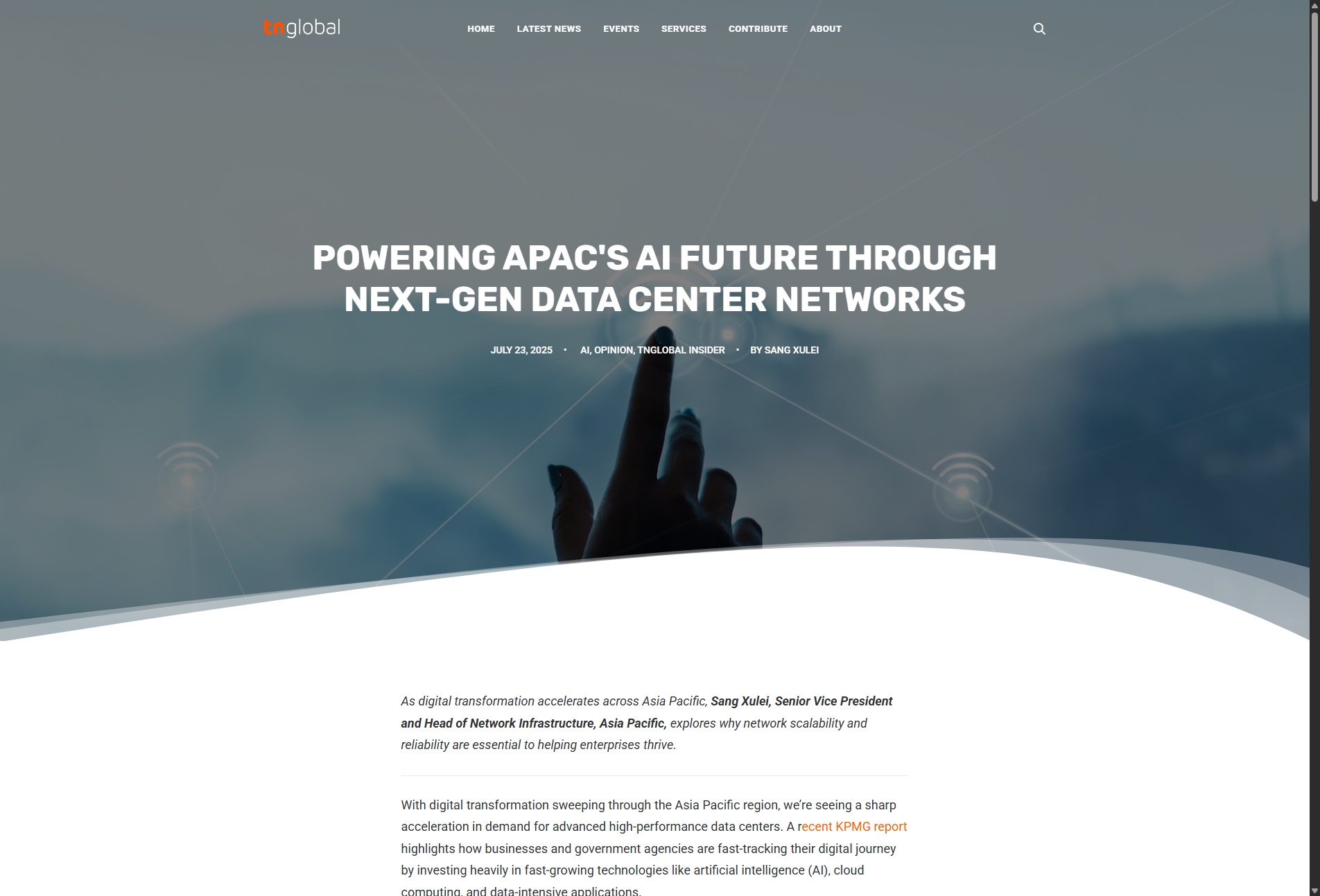As digital transformation accelerates across Asia Pacific, Sang Xulei, Senior Vice President and Head of Network Infrastructure, Asia Pacific, explores why network scalability and reliability are essential to helping enterprises thrive.
With digital transformation sweeping through the Asia Pacific region, we’re seeing a sharp acceleration in demand for advanced high-performance data centers. A recent KPMG report highlights how businesses and government agencies are fast-tracking their digital journey by investing heavily in fast-growing technologies like artificial intelligence (AI), cloud computing, and data-intensive applications.
Naturally, I see this demand for reliable data centers as both an opportunity and a challenge. In my experience, as enterprises become more digital, their operations also become increasingly dependent on network performance.
One thing is clear: legacy systems, built around siloed architectures and fragmented technologies, can no longer keep up. Today, enterprises need a unified infrastructure approach that can handle multi-technology solutions, automate operations, and protect performance under pressure.
Meeting this need requires visionaries who can design systems that are flexible and robust enough to meet changing demands. The result? A brighter future with faster growth rates, fewer errors, and improved performance.
And on a broader level, APAC is already facing an era of AI workloads, data analytics, and hybrid cloud environments, which are pushing systems to their limits.
Building future-ready networks for enterprise growth
I believe the key to navigating this era lies in taking data center networking to a new level. A recent IDC survey found that 60 percent of enterprises now prefer a platform-based approach, moving away from best-of-breed models that increase complexity and risk. In today’s environment, simplicity breeds reliability.
Modern networks call for centralized control platforms that can orchestrate security, visibility, and automation across hybrid environments. As enterprises scale, especially with AI integration, the importance of high-capacity, low-latency interconnects becomes critical. We know that whether training large language models or running inferencing tasks, reliable networking takes priority.
The backbone of AI infrastructure is no longer just about raw compute, it’s also about how well the front- and back-end networks are designed. AI workloads increase demand on both metro and long-haul data center interconnect (DCI) networks. These must dynamically scale and support and ensure ultra-high reliability service with availability up to 99.999 percent.
Of course, leading providers in the region are addressing this with advanced Data Center Fabric (DCF) and IP-optical DCI solutions, offering high-performance connectivity inside the data center and across clouds, wide area networks (WANs), and the internet. These technologies are now essential components of AI-ready infrastructure.
Towards resilience with automation
Moving on to building greater resilience, we realized that as data centers grow more complex, manual management is no longer sustainable. However, automation remains a daunting topic for many network teams. Real-world deployment requires not just tools, but ecosystems, where software, platforms, and operational workflows can interoperate seamlessly. As this blog on automation ecosystems explains, the key to success lies in integration.
True automation is event-driven. It senses what’s happening in the network, analyses it in real-time, and takes immediate action. This shift, from reactive responses to proactive resolutions, is vital in avoiding costly outages.
One solution shaping this trend is event-driven automation (EDA). EDA platforms offer real-time visibility and automatically help networks fix themselves before users feel any impact. This capability helps enterprises run operations more smoothly and scale with confidence.
As outlined in “Next-gen networkers need next-gen automation”, organizations that embrace real-time, condition-based automation see improvements in uptime, agility, and efficiency, which are essentials in today’s digital-first era of AI.
Scaling securely for the AI era
As we move deeper into the AI era, enterprise needs are evolving fast. Hybrid clouds, data sovereignty concerns, and increasing cybersecurity threats are changing how networks are designed and managed. AI workloads, in particular, demand ultra-reliable, high-bandwidth, low-latency connections across geographies and systems.
Networks must now support every stage of the data center lifecycle, from day-zero deployment to real-time operational adjustments. In this blog on optimizing networking for AI, achieving this level of performance requires tools that can adapt to fluctuating capacity demands and maintain performance at scale.
Looking at recent partnerships in the region, we can see this shift. In April 2025, Australian cloud provider ResetData selected a comprehensive networking backbone to support its rollout of sovereign ‘AI Factory’ data centers across the continent. These facilities are designed to meet rising local AI training and inference needs.
Similarly, in November 2024, Keppel Ltd. and a key technology partner signed an MoU to co-develop quantum-secure, AI-centric data centers. These new next-gen facilities will protect business systems from future risks and keep them running at a high level.
These developments reflect a clear regional momentum moving toward data center networks that are intelligent, adaptive, and secure by design.
Answering the challenge
So to sum up: how can we keep pace in an era increasingly defined by AI and data-intensive applications? The simple answer lies in building data centre networks that are not only scalable but also capable of meeting the stringent connectivity demands of next-generation AI workloads.
However, the road to achieving this can be complex, and not a challenge any single player can solve alone. I believe that to ensure progress, governments, enterprises, and technology leaders will need to collaborate more closely to build infrastructure that enables sustainable, inclusive digital growth.
As one of the leaders in this space, we are committed to delivering more than connectivity and collaborating to create the foundations that will build a smarter, faster, more resilient digital future for us all.
Mr. Sang Xulei is the Senior Vice President and Head of the Network Infrastructure (NI) Business Group for Asia Pacific (APAC) Market at Nokia. In this role, Sang leads the NI business across the APAC region, including India and Greater China, managing sales, pre-sales, delivery, and program management for Nokia’s IP, Optical, and Fixed Networks.
With 30 years of experience in the telecommunications industry, Sang brings extensive knowledge and expertise in network technologies and solutions. His proficiency spans across Fixed Broadband, Optical Networking, IP Routing, Network Automation and Slicing, Security, Cloud, Data Center, and AI. Throughout his career at Nokia, he has held various technical and leadership positions, contributing significantly to the company’s success.
Sang holds two bachelor’s degrees in Electrical Engineering and International Finance from Shanghai Jiaotong University in Shanghai, China. Additionally, he has obtained an Executive MBA (EMBA) from the China Europe International Business School (CEIBS).
Based in Singapore, Sang continues to drive innovation and excellence in the telecommunications sector, leveraging his rich experience and deep understanding of both business and technology.








